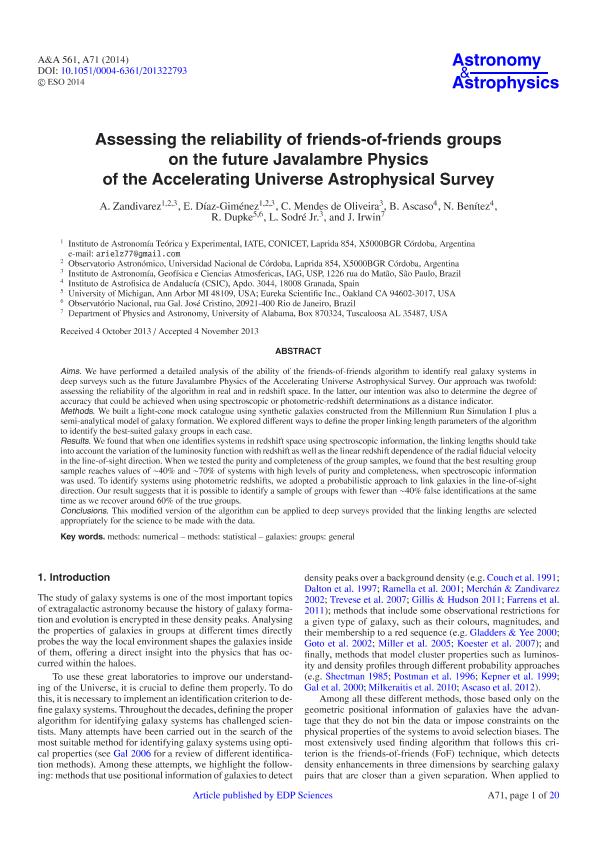Mostrar el registro sencillo del ítem
dc.contributor.author
Zandivarez, Arnaldo Ariel

dc.contributor.author
Diaz, Maria Eugenia

dc.contributor.author
Oliveira, Claudia Mendes de
dc.contributor.author
Ascaso, B.
dc.contributor.author
Benítez, N.
dc.contributor.author
Dupke, R.
dc.contributor.author
Sodré, L.
dc.contributor.author
Irwin, J.
dc.date.available
2018-01-04T21:18:51Z
dc.date.issued
2014-01
dc.identifier.citation
Irwin, J.; Sodré, L.; Dupke, R.; Benítez, N.; Ascaso, B.; Oliveira, Claudia Mendes de; et al.; Assessing the reliability of friends-of-friends groups on the future Javalambre Physics of the Accelerating Universe Astrophysical Survey; EDP Sciences; Astronomy and Astrophysics; 561; 1-2014; 71-91; A71
dc.identifier.issn
0004-6361
dc.identifier.uri
http://hdl.handle.net/11336/32378
dc.description.abstract
Aims: We have performed a detailed analysis of the ability of the friends-of-friends algorithm to identify real galaxy systems in deep surveys such as the future Javalambre Physics of the Accelerating Universe Astrophysical Survey. Our approach was twofold: assessing the reliability of the algorithm in real and in redshift space. In the latter, our intention was also to determine the degree of accuracy that could be achieved when using spectroscopic or photometric-redshift determinations as a distance indicator. Methods: We built a light-cone mock catalogue using synthetic galaxies constructed from the Millennium Run Simulation I plus a semi-analytical model of galaxy formation. We explored different ways to define the proper linking length parameters of the algorithm to identify the best-suited galaxy groups in each case. Results: We found that when one identifies systems in redshift space using spectroscopic information, the linking lengths should take into account the variation of the luminosity function with redshift as well as the linear redshift dependence of the radial fiducial velocity in the line-of-sight direction. When we tested the purity and completeness of the group samples, we found that the best resulting group sample reaches values of ~40% and ~70% of systems with high levels of purity and completeness, when spectroscopic information was used. To identify systems using photometric redshifts, we adopted a probabilistic approach to link galaxies in the line-of-sight direction. Our result suggests that it is possible to identify a sample of groups with fewer than ~40% false identifications at the same time as we recover around 60% of the true groups. Conclusions: This modified version of the algorithm can be applied to deep surveys provided that the linking lengths are selected appropriately for the science to be made with the data.
dc.format
application/pdf
dc.language.iso
eng
dc.publisher
EDP Sciences

dc.rights
info:eu-repo/semantics/openAccess
dc.rights.uri
https://creativecommons.org/licenses/by-nc-sa/2.5/ar/
dc.subject
Methods: Numerical
dc.subject
Methods: Statistical
dc.subject
Galaxies: Groups: General
dc.subject.classification
Astronomía

dc.subject.classification
Ciencias Físicas

dc.subject.classification
CIENCIAS NATURALES Y EXACTAS

dc.title
Assessing the reliability of friends-of-friends groups on the future Javalambre Physics of the Accelerating Universe Astrophysical Survey
dc.type
info:eu-repo/semantics/article
dc.type
info:ar-repo/semantics/artículo
dc.type
info:eu-repo/semantics/publishedVersion
dc.date.updated
2018-01-03T20:57:56Z
dc.journal.volume
561
dc.journal.pagination
71-91; A71
dc.journal.pais
Francia

dc.description.fil
Fil: Zandivarez, Arnaldo Ariel. Consejo Nacional de Investigaciones Científicas y Técnicas. Centro Científico Tecnológico Conicet - Córdoba. Instituto de Astronomia Teórica y Experimental. Universidad Nacional de Córdoba. Observatorio Astronómico de Córdoba. Instituto de Astronomia Teórica y Experimental; Argentina. Universidade do Sao Paulo. Instituto Astronomia, Geofisica e Ciencias Atmosfericas; Brasil
dc.description.fil
Fil: Diaz, Maria Eugenia. Consejo Nacional de Investigaciones Científicas y Técnicas. Centro Científico Tecnológico Conicet - Córdoba. Instituto de Astronomia Teórica y Experimental. Universidad Nacional de Córdoba. Observatorio Astronómico de Córdoba. Instituto de Astronomia Teórica y Experimental; Argentina. Universidade do Sao Paulo. Instituto Astronomia, Geofisica e Ciencias Atmosfericas; Brasil
dc.description.fil
Fil: Oliveira, Claudia Mendes de. Universidade do Sao Paulo. Instituto Astronomia, Geofisica e Ciencias Atmosfericas; Brasil
dc.description.fil
Fil: Ascaso, B.. Instituto de Astrofisica de Andalucía ; España
dc.description.fil
Fil: Benítez, N.. Instituto de Astrofisica de Andalucía ; España
dc.description.fil
Fil: Dupke, R.. University of Michigan; Estados Unidos
dc.description.fil
Fil: Sodré, L.. Universidade do Sao Paulo. Instituto Astronomia, Geofisica e Ciencias Atmosfericas; Brasil
dc.description.fil
Fil: Irwin, J.. University of Alabama; Estados Unidos
dc.journal.title
Astronomy and Astrophysics

dc.relation.alternativeid
info:eu-repo/semantics/altIdentifier/url/https://www.aanda.org/articles/aa/abs/2014/01/aa22793-13/aa22793-13.html
dc.relation.alternativeid
info:eu-repo/semantics/altIdentifier/doi/http://dx.doi.org/10.1051/0004-6361/201322793
Archivos asociados
